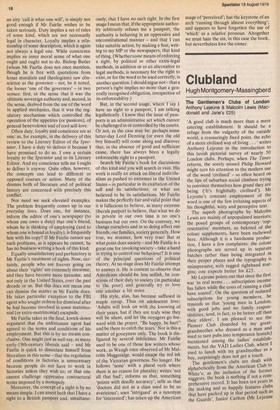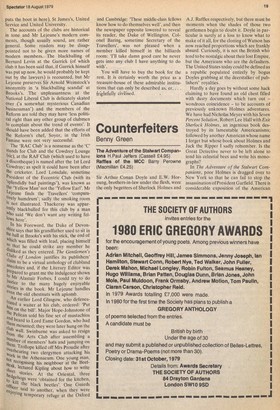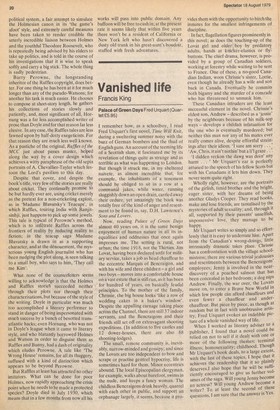Clubland
Hugh Montgomery-Massingberd
The Gentlemen's Clubs of London Anthony LejeUne & Malcolm Lewis (Macdonald and Jane's E25) 'A good club is much more than a mere catering establishment. It should be a refuge from the vulgarity of the outside world, a reassuringly fixed point, the echo of a more civilised way of living. . . 'writes Anthony Lejeune in the introduction to this lavish pictorial survey of nearly 50 London clubs. Perhaps, when The Times returns, the sorely missed Philip Howard might turn his attention to the modern use of the word 'civilised' — so often heard on the lips of suburban social climbers trying to convince themselves how grand they are being ('It's frightfully civilised'). Mr Lejeune's constant employment of the word is one of the few irritating aspects of his thoughtful, witty and perceptive text. The superb photographs by Malcolm Lewis are mainly of unpopulated interiors; the posed groups of contemporary 'representative' members, so beloved of the colour supplements, have been eschewed here. Although it is a handsome production, I have a few complaints: the colour photographs are served up in separate batches rather than being integrated in their proper places and the typography is unimpressive, with ragged righthand margins: one expects better for £25. Mr Lejeune points out that since the first war in real terms . . . subscription income has fallen while the costs of running a club have soared'. On the question of reduced subscriptions for young members, he reminds us that 'young men in London, with good jobs and no family responsibilities, tend, in fact, to be better off than their elders'. I am pleased to see the Pioneer Club (founded by my greatgrandmother who dressed as a man and used to turn pubs into temperance hostels) mentioned among the ladies' establishments, but the VAD Ladies Club, where I used to lunch with my grandmother as a boy, surprisingly does not get a touch. The gentlemen's clubs are dealt with alphabetically from the American Club to White's: as the inclusion of the former suggests, the book is nothing if not a comprehensive record. It has been ten years in the making and so happily features clubs that have packed up in that period such as the Guards', Junior Carlton (Mr Lejeune puts the boot in here), St James's, United Service and United University.
The accounts of the clubs are historical in tone and Mr Lejeune's modern comments, though usually sound, are rather general. Some readers may be disappointed not to be given more names of modern members. The blackballing of Bernard Levin at the Garrick (of which club it has been said that, if Garrick himself was put up now, he would probably be kept out by the lawyers) is recounted, but Mr Lejeune preserves Sir Arnold Weinstock's anonymity in 'a blackballing scandal' at Brooks's. The unpleasantness at the National Liberal Club is delicately skated over ('a somewhat mysterious Canadian businessman') and the members of the Reform are told they may have 'less political right than any other group of clubmen to complain about the trend of events'. It Should have been added that the efforts of the Reform's chef, Soyer, in th,e Irish Famine were not very successful.
The 'RAC Club' is a nonsense as the 'C' stands for Club and the Cowdrey Lounge at the RAF Club (which used to have a discotheque) is named after the 1st Lord Cowdray; as spelt it could have been after the cricketer. Lord Lonsdale, sometime President of the Eccentric Club (with its sPlendidly bad paintings'), was known as the 'Yellow Man' not the 'Yellow Earl'. Mr Lejeune finds the Travellers' compara,tively humdrum'; sadly the smoking room IS not illustrated. Thackeray was apparently blackballed for this club by a man who said 'We don't want any writing fel lows here'. , In his Foreword, the Duke of DevonShire says that his grandfather used to sit in the hall at Brooks's with his stick, the end of which was filled with lead, placing himself so that he could strike any member he disliked as they entered. The Gentlemen's Clubs of London justifies its publishers' claim to be a virtual anthology of clubland anecdotes and, if the Literary Editor was rePared to grant me the indulgence shown , Mr Alastair Forbes, I could try to do Justice to the many hugely enjoyable stories in the book. Mr Lejeune handles even the old chestnuts with aplomb. , A.11 earlier Lord Glasgow. who defeneskl,ated a waiter at his club, ordered: 'Put 11111 on the Major Hope-Johnstone of 0 Pelican sold his fine set of mustachios tgind beard to Lord Esme Gordon, who had entent mounted; they were later hung on the , hub Swinburne was asked to resign n om the Arts Club after assembling a otitInher of members' hats and jumping on em Trollope killed off Mrs Proudie after erhearing two clergymen attacking his _wootrk in the Athenaeum. One young man, snte recognising his neighbour at the Beetlectured Kipling about how to write stories. At the Oriental, three ugehogs were 'obtained for the kitchen, `c) °Mekill the black beetles'. One Guards er • and Cambridge: 'These middle-class fellows know how to do themselves well', and then the newspaper opposite lowered to reveal its reader, the Duke of Wellington. Colonel Baring, sometime Secretary of the Travellers', was not pleased when a member killed himself in the billiards room: 'I'll take damn good care he never gets into any club I have anything to do with'.
You will have to buy the book for the rest. It is certainly worth the price as a treasure-house of these admirable institutions that can only be described as, er, frightfully civilised. A.J. Raffles respectively, but there must be moments when the shades of those two gentlemen begin to doubt it. Doyle in particular is surely at a loss to know what to make of it all, for the cloning of Watson has now reached proportions which are frankly absurd. Curiously, it is not the British who tend to be nostalgic about their lost Empire, but the Americans who are the defaulters. The United States today could be defined as a republic populated entirely by bogus Doyles grabbing at the deerstalker of publishers' royalties.
Hardly a day goes by without some hack claiming to have found an old chest filled with dusty documents which turn out — wondrous coincidence — to be accounts of previously unknown Holmes adventures. We have had Nicholas Meyer with his Seven Percent Solution, Robert Lee Hall with Exit Sherlock Holmes, an ingenious book destroyed by its lamentable Americanisms; folldwed by another American whose name I forget but whose book about Holmes and Jack the Ripper I sadly rehiember. Is the Great Detective never to be left alone to tend his celestial bees and write his monographs?
In The Adventure of the Stalwart Companions, poor Holmes is dragged over to New York so that he can fail to stop the assassination of President Garfield. There is considerable exposition of the American political system, a fair attempt to simulate the Holmesian canon in its 'the game's afoot' style, and extremely careful measures have been taken to render credible the utterly incredible liaison between Holmes and the youthful Theodore Roosevelt, who is repeatedly being advised by his elders to take up politics, and is told in the course of his investigations that it is wise to speak softly and carry a big stick. The whole thing is sadly pedestrian.
Barry Perowne, the longstanding inheritor of the Raffles copyright, does better. For one thing he has been at it for much longer than any of the pseudo-Watsons; for another his task is much easier. He chooses to compose at short-story length, he gathers his collections of stories slowly and patiently, and, most significant of all, Hornung was a far less accomplished writer of prose than Doyle and for that reason far less elusive. In any case, the Raffles tales are less fawned upon by half-dotty exegeticists. For that reason they are much less well known. As a pastiche of the original, Raffles of the MCC just about passes muster, helped along the waS'i by a cover design which achieves a witty paraphrase of the old sepia portraits of A. Chevallier-Tayler which festoon the Lord's pavilion to this day.
Despite that cover, and despite the book's title, very few of the stories are really about cricket. They continually promise to be but hardly ever are, using cricket merely as the pretext for a non-cricketing exploit, as in 'Madame Blavatsky's Teacups', in which Raffles, touring India with Ranjitsinhji, just happens to pick up some jewels. This tale is typical of Perowne's method, which is to infiltrate Raffles across the frontiers of reality by reducing reality to fiction; in the teacup saga Madame Blavatsky is drawn in as a supporting character, and at the denouement, the mysterious young English journalist who has been nudging the plot along, is seen talking to a small boy, who says to him, 'They call me Kim'.
What none of the counterfeiters seems willing to acknowledge is that the Holmes and Raffles stories succeeded neither through their plots nor through their characterisations, but because of the style of the writing. Doyle in particular was much too accomplished a literary performer to stand in danger of being impersonated with much success by a bunch of besotted transatlantic hacks; even Hornung, who was not in Doyle's league when it came to literary style, and who blatantly borrowed Holmes and Watson in order to disguise them as Raffles and Bunny, had a dash of originality which eludes Perowne. A tale like 'The Wrong House' remains, for all its thuggery, suffused with a kind of distinction which appears to be beyond Perowne.
But Raffles at least has attracted no other imitators. What can be done for poor Holmes, now rapidly approaching the crisis point when he needs to be made a protected species? Doyle died in July 1930, which means that in a few months from now all his works will pass into public domain. Any buffoon will be free to cash in; at the present rate it seems likely that within five years there won't be a resident of California or New York left who hasn't discovered a dusty old trunk in his great-aunt's boudoir, stuffed with fresh adventures.
































 Previous page
Previous page